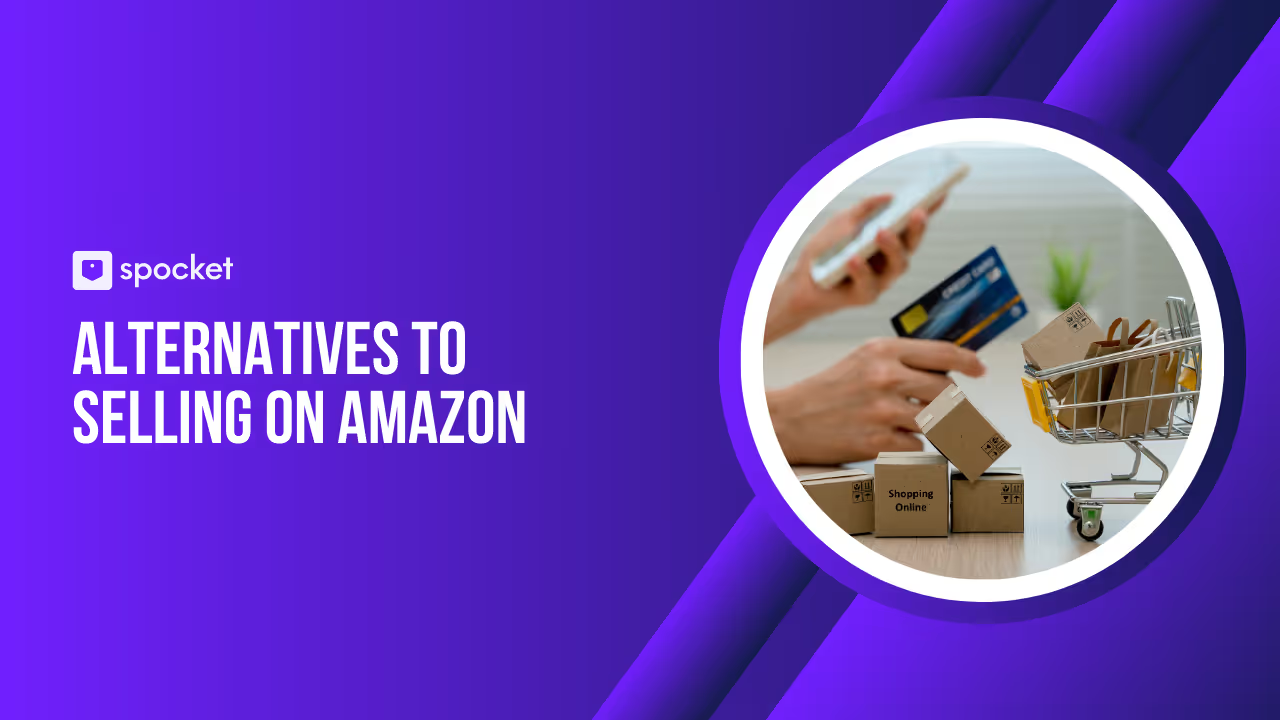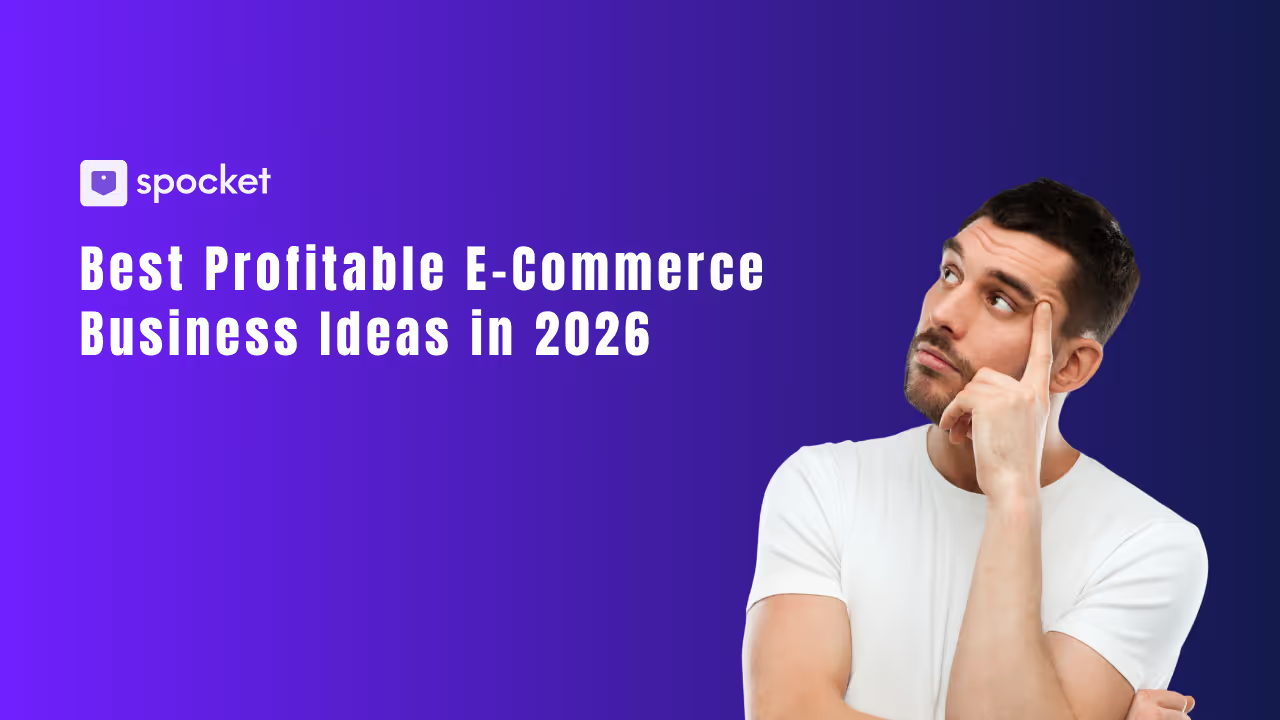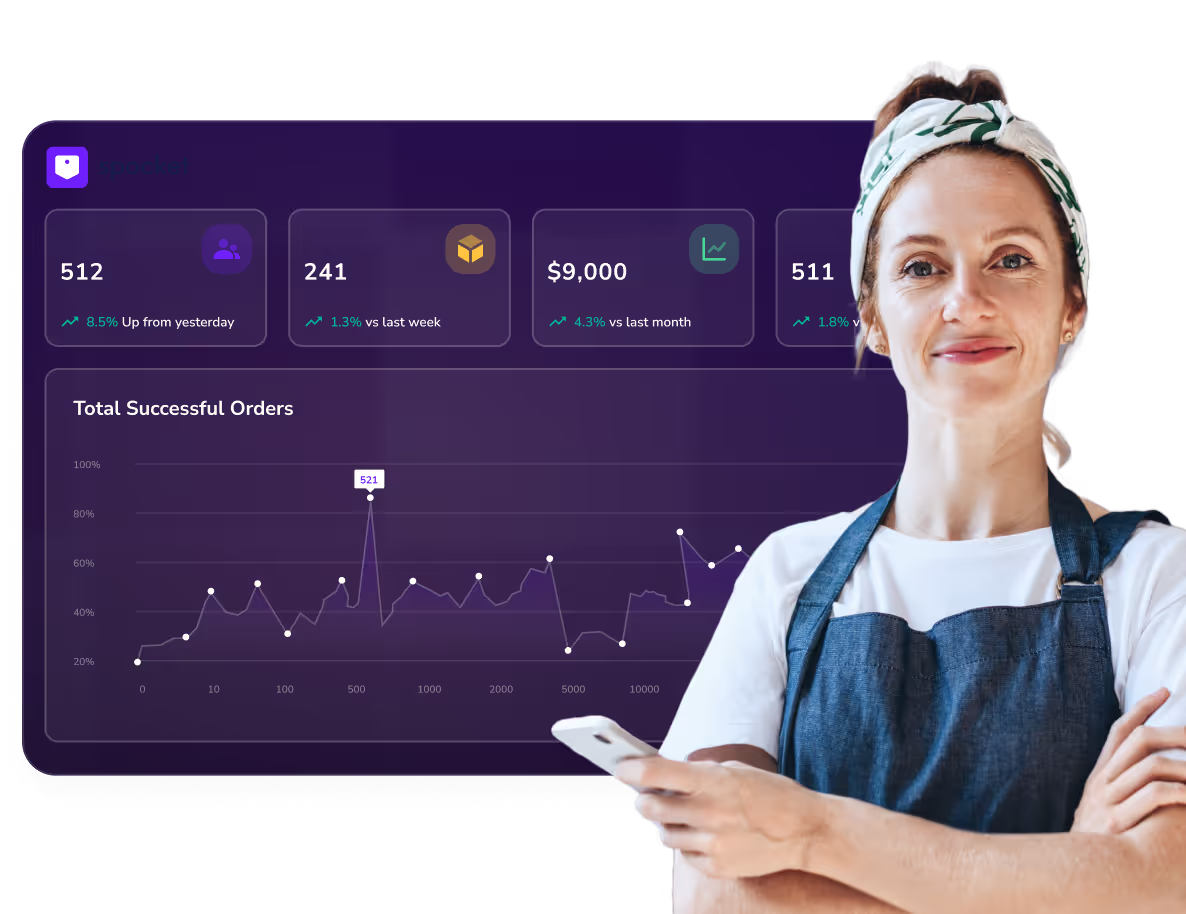While Amazon remains one of the largest e-commerce platforms globally, many entrepreneurs are exploring alternative selling platforms to avoid fierce competition, high fees, and reliance on Amazon’s strict policies. With the rise of new e-commerce tools and niche marketplaces, sellers can now find more flexibility, control, and potential profit. In this guide, we’ll explore some of the top alternatives to Amazon for selling products, ranging from specialized platforms that target specific markets to general online stores that offer lower fees and greater independence.
Whether you’re looking for a platform with fewer restrictions, lower fees, or unique customer demographics, these alternatives can help you expand your reach and grow your business in 2025.
7 Amazon Alternatives to Consider
Selling on Amazon offers numerous advantages, but it also comes with high competition, fees, and rules that can limit a seller’s flexibility. Fortunately, several alternative ecommerce platforms offer great opportunities for e-commerce entrepreneurs in 2025.
From niche marketplaces to platforms offering lower fees and greater control, here are seven Amazon alternatives to consider for expanding your online business.
Shopify
Shopify is a popular, user-friendly e-commerce platform that enables entrepreneurs to easily create and manage online stores. It offers powerful tools, scalability, and integrations to help businesses grow and succeed.

Pros of Selling on Shopify
- Easy to Use: Intuitive interface suitable for beginners.
- Scalable: Flexible plans for businesses of all sizes.
- Customizable Themes: Wide variety of design options to fit your brand.
- Extensive App Store: Over 4,000 apps to enhance functionality.
- Multi-Channel Integration: Sell across platforms like Amazon, eBay, and Instagram.
- 24/7 Customer Support: Access help anytime via chat, email, or phone.
Cons of Selling on Shopify
- Monthly Fees: Plans start at $29/month, which can increase with added apps and features.
- Transaction Fees: Fees on external payment gateways (2.9% + 30¢ per transaction).
- Limited Reporting on Basic Plan: The entry-level plan has fewer analytics tools.
Benefits of Selling on Shopify
- All-in-One Platform: Manage products, payments, and shipping from one place.
- Built-In Payment Processing: Shopify Payments simplifies transactions.
- Mobile Optimized: Fully mobile-friendly design for on-the-go shopping.
- Secure and Reliable: SSL certificates and PCI compliance ensure data protection.
- Marketing Tools: Built-in SEO, email marketing, and social media integrations to boost traffic.
eBay
eBay is one of the largest online marketplaces, providing an accessible platform for selling products globally. Known for its auction-style listings, eBay also offers fixed-price options, making it appealing to a broad range of sellers.

Pros of Selling on eBay
- Global Reach: Access to 185 million active buyers globally.
- Low Fees: Listing fees start at $0.30, and final value fees range from 8% to 12%.
- Flexible Selling: Options for both auction-style and fixed-price listings.
- Buyer Protection: eBay offers buyer protection and guarantees a secure transaction process.
- No Subscription Fees: No monthly subscription fees, you only pay when you sell.
Cons of Selling on eBay
- High Competition: Highly competitive categories can make it hard to stand out.
- Fees: Listing and final value fees can add up.
- Strict Policies: eBay has detailed rules that sellers must follow.
- Shipping and Returns: Sellers handle all shipping and returns, adding complexity.
- Limited Branding: Less control over how your store appears compared to standalone sites.
Benefits of Selling on eBay
- Massive Exposure: Reach millions of potential customers worldwide.
- Marketing Tools: Use Promoted Listings and other marketing options to boost visibility.
- Flexible Payment Options: Accept PayPal, credit cards, and Apple Pay.
- Trusted Platform: eBay’s global recognition increases buyer trust, leading to higher conversions.
Etsy
Etsy is an online marketplace focused on handmade, vintage, and unique items. It is popular among crafters, artists, and entrepreneurs selling one-of-a-kind products. With a strong community and niche audience, Etsy provides a great platform for creatives and small business owners.

Pros of Selling on Etsy
- Targeted Audience: Etsy attracts buyers looking for unique, handmade, and vintage items, giving sellers access to a niche, dedicated audience.
- Low Startup Costs: Listing fees are $0.20 per item, and transaction fees are relatively low compared to other platforms.
- Easy Setup: Creating a shop is quick and simple, with many customization options to reflect your brand’s style.
- Built-in Traffic: Etsy’s search engine and marketing tools help drive traffic to your listings.
- Global Market: Etsy has 96 million active buyers globally, giving you access to an international market.
Cons of Selling on Etsy
- High Fees: Etsy charges 5% transaction fees and 3% + $0.25 payment processing fees, which can add up quickly.
- Intense Competition: With millions of sellers, standing out in popular categories can be challenging.
- Limited Control: Customization options for your store are more limited than on independent websites.
- High Seller Fees for Ads: Etsy’s advertising costs can become high, especially if you’re in a competitive niche.
Benefits of Selling on Etsy
- Community Focus: Etsy has a strong sense of community among sellers and buyers, which can help build brand loyalty.
- Marketing Tools: Use Etsy Ads and promotional features to increase visibility and attract buyers.
- Seller Protection: Etsy provides buyer and seller protection, helping to resolve disputes and protect transactions.
- Low Barrier to Entry: No monthly fees for a basic store, making it ideal for those with limited startup capital.
BigCommerce
BigCommerce is a powerful e-commerce platform designed to help businesses build, manage, and scale their online stores. Known for its robust features and scalability, BigCommerce is suitable for businesses of all sizes, offering various tools to streamline sales, marketing, and inventory management.

Pros of Selling on BigCommerce
- Scalability: BigCommerce is ideal for businesses looking to scale, with features that grow with your business needs, from small startups to enterprise-level operations.
- Customizable Features: The platform offers flexible design and customization options, allowing you to tailor your store to your branding and customer experience.
- Built-In Marketing Tools: BigCommerce provides SEO tools, email marketing, and integrations with Google Shopping and Facebook, helping you drive traffic and sales.
- Multi-Channel Selling: Integrates easily with popular marketplaces like Amazon, eBay, and Facebook, allowing you to sell across multiple channels from a single platform.
- No Transaction Fees: Unlike some platforms, BigCommerce doesn’t charge transaction fees on sales, allowing you to keep more of your profits.
Cons of Selling on BigCommerce
- Monthly Subscription Fees: BigCommerce plans start at $29.95 per month, which can be a barrier for new or small businesses. The higher-tier plans can also be costly for growing stores.
- Learning Curve: While it’s feature-rich, BigCommerce can be difficult for beginners to navigate due to its complex tools and setup process.
- Design Limitations: Although customization is possible, some sellers find the design templates somewhat limiting compared to other platforms like Shopify.
- Transaction Fees for Payment Processors: If you use third-party payment gateways, such as PayPal or Stripe, additional fees may apply.
Benefits of Selling on BigCommerce
- Seamless Integrations: BigCommerce integrates with various tools and services, including payment gateways, shipping providers, and CRM tools, simplifying store management.
- Robust Analytics: BigCommerce offers detailed reporting and analytics, helping you track performance, sales trends, and customer behavior to make data-driven decisions.
- Mobile-Friendly: With a mobile-optimized interface, your store will perform well on smartphones and tablets, which is essential as mobile commerce continues to rise.
- Security and Reliability: BigCommerce provides SSL certificates and PCI-compliant payment systems, ensuring that customer data is secure and your store runs smoothly.
Wix for eCommerce
Wix is a popular website builder that allows users to create and manage e-commerce stores. Known for its drag-and-drop interface and customizable designs, Wix makes it easy to build an online store, even without technical expertise.

Pros of Using Wix for eCommerce
- User-Friendly: Intuitive drag-and-drop editor suitable for beginners.
- Customizable Templates: Wide range of e-commerce-focused templates to match your brand.
- Affordable: Plans start at $23/month, offering a cost-effective solution for small businesses.
- Built-In Payment Solutions: Wix provides integrated payment gateways like PayPal, Stripe, and Wix Payments.
- Mobile Optimized: Automatically optimized for mobile devices to reach a wider audience.
Cons of Using Wix for eCommerce
- Limited Scalability: While great for small to medium-sized businesses, Wix may not have all the features needed for large-scale operations.
- Transaction Fees: Wix charges 2.9% + 30¢ per transaction for credit card payments, and there are fees on some third-party payment processors.
- Limited Advanced Features: Advanced features may require third-party integrations, which could increase costs.
Benefits of Using Wix for eCommerce
- All-in-One Solution: Manage everything from products to payments in one platform.
- Affordable Plans: Wix offers low-cost plans compared to other e-commerce platforms.
- SEO Features: Built-in SEO tools to help increase visibility on search engines.
- App Market: Access to a variety of apps to add extra functionality, such as marketing tools and customer management systems.
- 24/7 Support: Wix provides customer support to assist with any issues that arise.
Bonanza
Bonanza is an online marketplace that enables sellers to list and sell products across a variety of categories, including fashion, home goods, electronics, and more. Known for its simplicity and low fees, Bonanza is an appealing alternative to more well-established platforms like eBay and Amazon.

Pros of Selling on Bonanza
- Low Fees: Bonanza offers some of the lowest fees in the industry, with 3.5% transaction fees and no listing fees.
- Easy to Use: The platform is simple to navigate, allowing sellers to set up their stores and list products quickly.
- Integration with eBay and Amazon: Bonanza allows sellers to import their listings from eBay and Amazon, expanding their reach to more customers.
- Customizable Storefronts: Sellers can personalize their stores with unique themes and branding options.
- No Subscription Fees: Unlike other platforms like Amazon and eBay, Bonanza doesn’t require monthly subscription fees to list products.
Cons of Selling on Bonanza
- Smaller Audience: While Bonanza is growing, its audience is still much smaller than Amazon or eBay, which can limit your potential customer base.
- Limited Marketing Tools: Bonanza’s marketing tools are less robust than those of larger platforms, so you may need to rely on external advertising for more exposure.
- Limited Payment Options: While Bonanza integrates with PayPal, it offers fewer payment gateways compared to other platforms like Shopify or eBay.
- Seller Support: Some sellers report that customer support can be slow to respond to inquiries and issues.
Benefits of Selling on Bonanza
- Cost-Effective: Bonanza's low transaction fees and no listing fees make it an affordable option for new and small businesses.
- Global Market Access: Sellers can reach a worldwide audience without incurring significant additional costs.
- Automated Tools: Bonanza offers automated import tools from eBay and Amazon, helping sellers streamline their operations.
- Secure Payment: Bonanza provides secure payments through PayPal, ensuring peace of mind for both buyers and sellers.
- Flexibility: Sellers have more control over their listings, allowing them to personalize product pages and create unique storefronts.
Newegg
Newegg is a leading online marketplace primarily focused on electronics, computer hardware, and tech products. It offers a platform for both large and small businesses to sell products, making it a popular choice for those in the technology sector. With a reputation for quality tech goods and an extensive product range, Newegg is a strong alternative to platforms like Amazon.

Pros of Selling on Newegg
- Tech-Focused Audience: Newegg is known for its tech-savvy customer base, making it an excellent platform for selling electronics, gaming equipment, and computer parts.
- Low Seller Fees: Compared to platforms like Amazon, Newegg charges lower seller fees, making it more cost-effective for businesses.
- Reputation for Quality: Newegg has a solid reputation for selling high-quality tech products, which can help build trust with buyers.
- Global Reach: Newegg serves over 80 countries, allowing sellers to tap into an international market.
- Promotional Tools: Newegg provides marketing tools such as discounts, promotions, and featured product listings to help increase visibility.
Cons of Selling on Newegg
- Limited Product Categories: Newegg’s focus on tech and electronics means it may not be suitable for sellers with non-tech products.
- Approval Process: The platform has a more rigorous application and approval process compared to other marketplaces, which can be a barrier for new sellers.
- Higher Shipping Costs: International shipping costs can be high, especially for bulky or heavy tech items.
- Competition in Tech: With so many sellers offering similar products, standing out in the tech category can be difficult without effective marketing strategies.
Benefits of Selling on Newegg
- Strong Tech-Focused Market: Newegg’s specialized audience is ideal for tech products, increasing your chances of finding the right customers.
- No Monthly Fees: Sellers are not required to pay monthly subscription fees, making it easier for smaller businesses to get started.
- Low Transaction Fees: Newegg’s transaction fees are relatively low compared to other major platforms like Amazon, meaning more profit per sale.
- Seller Protection: Newegg offers buyer protection and secure payment processing, ensuring a safe transaction process for both buyers and sellers.
- Customizable Storefront: Sellers can create personalized storefronts, adding a unique touch to their e-commerce presence on the platform.
Conclusion: Alternatives to Selling on Amazon
While Amazon remains a dominant force in e-commerce, there are many viable alternatives for entrepreneurs looking to diversify their sales channels and avoid the intense competition, high fees, and rigid policies associated with Amazon. Platforms like eBay, Shopify, Etsy, and BigCommerce offer unique advantages, whether you're looking for a niche market, lower fees, or more control over your brand. By exploring these alternatives, you can find the platform that best suits your products, audience, and business goals. With the right strategy and tools, you can build a successful online business without relying solely on Amazon.







































